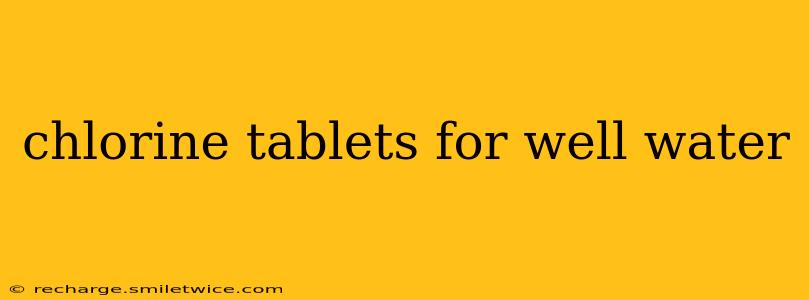Maintaining clean and safe well water is crucial for the health of your household. Chlorine tablets offer a convenient and effective method for disinfecting your well water, eliminating harmful bacteria, viruses, and other microorganisms. This guide delves into the specifics of using chlorine tablets for well water treatment, addressing common questions and concerns.
What are Chlorine Tablets Used For in Well Water Treatment?
Chlorine tablets, typically containing calcium hypochlorite, are a common and effective way to disinfect well water. They release chlorine into the water, killing harmful bacteria, viruses, and other pathogens that can cause serious illnesses. This process, known as shock chlorination, is essential for eliminating contaminants and ensuring your water is safe for drinking, bathing, and other household uses. Regular disinfection with chlorine tablets prevents future contamination and safeguards your family's health.
How Often Should I Shock My Well with Chlorine Tablets?
The frequency of shocking your well depends on several factors, including the age and condition of your well, the surrounding soil conditions, and the level of contamination. However, a general recommendation is to shock your well at least once a year, and more frequently if you suspect contamination or experience a period of heavy rainfall. Regular testing of your well water can help determine the appropriate frequency. Your local health department or a water testing service can provide guidance tailored to your specific situation.
How Many Chlorine Tablets Do I Need for My Well?
The required number of chlorine tablets depends on the size and depth of your well. There's no one-size-fits-all answer. The instructions on your specific brand of chlorine tablets will usually provide a recommended dosage based on the volume of water in your well. It's crucial to follow these instructions carefully to ensure effective disinfection without over-chlorinating. Contacting a water treatment professional can help you determine the correct amount for your well. Under-chlorination is less effective; over-chlorination can be harmful and potentially damage your well pump and plumbing.
What are the Potential Side Effects of Using Too Many Chlorine Tablets?
Using too many chlorine tablets can lead to several undesirable consequences:
- High Chlorine Levels: Excessively high chlorine levels in your drinking water can result in a harsh, unpleasant taste and odor. It can also cause health problems in some individuals.
- Corrosion: High chlorine concentrations can corrode metal pipes and fixtures in your plumbing system, leading to premature damage and costly repairs.
- Environmental Impact: Excess chlorine can harm beneficial microorganisms in the surrounding environment.
Therefore, it is always advisable to carefully follow the manufacturer's instructions and, if in doubt, consult a professional.
How Do I Properly Use Chlorine Tablets for Well Water Treatment?
Properly using chlorine tablets involves several key steps:
- Determine the correct dosage: Follow the instructions provided on your chlorine tablet packaging or consult a water treatment professional.
- Dissolve the tablets: Carefully dissolve the chlorine tablets in a bucket of water before adding them to your well.
- Add to the well: Slowly pour the chlorine solution into your well. If your well has a submersible pump, add the solution directly into the well casing.
- Circulate the water: Let the chlorine solution circulate throughout the well. This ensures thorough disinfection. This may require running your well pump for a specific duration—again, consult the product instructions for guidance.
- Wait: Allow the chlorine to remain in the well for the specified amount of time, usually 12-24 hours.
- Flush the system: After the waiting period, thoroughly flush the system by running all water taps for a period, until the chlorine odor is gone.
How Do I Know if My Well Water is Safe After Using Chlorine Tablets?
After shocking your well, it's crucial to test your water to ensure the chlorine levels have decreased to a safe range. You can purchase a chlorine test kit at most hardware stores or pool supply shops. If the chlorine levels are still high, continue to flush the system until they are within the acceptable range. You should also test for other contaminants, such as bacteria and coliform levels, to ensure the treatment has been effective. Your local health department can advise on appropriate testing and interpretations.
Using chlorine tablets is an effective method for disinfecting your well water, but safety and efficacy require careful planning and execution. Always follow the manufacturer's instructions, conduct regular water testing, and consider consulting a water treatment professional for personalized advice.
